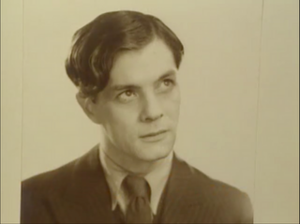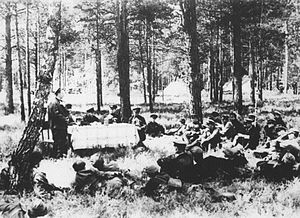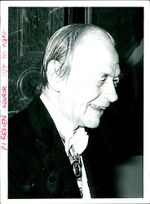G. C. Lorenzo
G. C. Lorenzo | |
|---|---|
 Lorenzo in 1945 | |
| Birth name | Xoanicio Cristóbalo Vargas y Lorenzo |
| Nickname(s) | Lorenzo of Volonia |
| Born | 17 September 1904 Flordeterra, Baia |
| Died | 23 June 2002 (aged 97) Mauritius, Baia, Castadilla |
| Buried | Flordetierra, Baia, Castadilla |
| Allegiance | Baia Delepasia Volonia |
| Service/ | Baian Royal Army Imperial Intelligence Bureau |
| Years of service | 1922-1924 1929-1945 |
| Rank | Major |
| Battles/wars | Second Great War
|
| Awards | Order of Los Rumas and Las Joquis Legion of Valour |
Gianizio Cristofano Lorenzo (né Xoanicio Cristóbalo Vargas y Lorenzo; September 17, 1904 – June 23, 2002) was a Baian (later Delepasian) soldier, intelligence officer, anthropologist and author. He is best known for his pivotal role in the Volonian Revolt (1939-43) against the Imperium of Caphiria. The sheer breadth and variety of his deeds and associations during the successful revolt, helped along by the fantastically vivid descriptions of those events in his wartime journal, had earned him the internationally-renowned nickname Lorenzo of Volonia, which was used as the title of the 1985 film based on his wartime activities.
Born in Flordeterra, Baia in September 1904 to Flora Lorenzo (1877-1978), a former governess, and Don Tomas de Rivera (1872-1905), an aristocrat. De Rivera had eloped with Lorenzo in 1899, the two calling themselves Sr. and Sra. Vargas to avoid getting caught. After Lorenzo's birth, his father died less than four months later on board a liner that had sank after striking a rock off the coast of Valio. Lorenzo's military career started in 1922 with his enlistment into the Baian Royal Army. Due to his aptitude in the initial tests at the beginning of his conscription, he caught the attention of the commander of the Royal Baian Guard regiment who wished to recruit him into the elite Royal Baian Guard, which later became the Imperial Delepasian Guard. Lorenzo eventually caught the attention of recruiters for the Imperial Intelligence Bureau in the early 1930s, who eventually recruited him into the OI.
Soon after his transfer into the OII in 1931, he and Colonel Xurxo Videla were sent to what is now the Volonian capital of Caradej, then a part of Caphiria, to ostensibly conduct anthropological studies, while clandestinely being assigned intelligence missions to establish contact with underground Volonian nationalist groups and to send them weapons and supplies in preparation for the eventual armed struggle. With the start of the Second Great War in 1934, Lorenzo quickly became involved with these groups and eventually took a lead role in the Volonian Revolt when it started in 1939. The revolt would end in 1943 with Volonia winning their independence, a fact that was declared in the Treaty of Kartika.
After the end of the war, he continued to serve the OII until 1945 when he resigned to pursue his greatest passion, the field of anthropology, at De Rivera University. During this time, Professor Guillermo Arnes encouraged Lorenzo to publish what would become his best-known work Testament of Volonia (1952), an autobiographical account of his participation in the Volonian Revolt. He also translated books into Pelaxian, and wrote The Assembly Line (1972), which detailed his time in the Imperial Intelligence Bureau in the years leading up to the Second Great War. He corresponded extensively and was friendly with people from all sorts of professions from well-known artists to writers and politicians.
Lorenzo's public image resulted in part from the sensationalised reporting of the Volonian Revolt in the Alstinian press, as well as from Testament of Volonia. On 23 June 2002, Lorenzo passed away peacefully at the age of 97.
Early life
Xoanicio Cristóbalo Vargas y Lorenzo was born on 17 September 1904 in Flordeterra in the Kingdom of Baia. His Delepasian father Tomas de Rivera had eloped with Flora Lorenzo, who had been governess to his younger siblings, in 1899 and took on the name Vargas. Flora herself was the daughter of immigrants from the island of Urlazio. Lorenzo had two older siblings named Teresa (1900-2005), and Miguel (1902-1958). De Rivera died in January of 1905 after the liner he was on struck some rocks and sank. Flora soon married Hugo Ximenes (1879-1930) in 1906. Ximenes was a local civil servant and a veteran of the First Great War. A pacifist due to his experiences in the war, he tried to pass on these beliefs to his stepchildren. Problem was, as Lorenzo recounted, Ximenes was an alcoholic who was rarely ever sober and had a real nasty temper that often led to him beating his wife and stepsons (though he got along very well with Teresa). When Ximenes died from alcohol-induced liver failure in 1930, Lorenzo and his siblings decided to legally change their names, with Lorenzo himself changing his name to Gianizio Cristofano Lorenzo. During his schooling, he developed an interest in history and anthropology thanks to, as Lorenzo put it, his history teacher.
Travels, antiquities, and archaeology
At the age of 15, Lorenzo travelled with his schoolfriend Pedro Vila around both Baia and Rosario, visiting almost every church whether it be major cathedrals to small village parish churches, studying their monuments and antiquities, and making rubbings of their monumental brasses. Lorenzo and Vila monitored building sites in Los Rumas, Santa Maria, and Mauritius and presented whatever they have found to the Great Vallosi Museum. The museum's Annual Report for 1919 said that the two teenage boys "by incessant watchfulness secured everything of antiquarian value which has been found in not only Baia, but in Rosario as well." In the summers of 1920 and 1921, Lorenzo toured Lucrecia by bicycle, sometimes with Vila, collecting photographs, drawings, and measurements of medieval fortresses. In August of 1921, Lorenzo wrote home: "The Lucrecians have complimented me on my ability to get their vernacular of Pelaxian down wonderfully: I have been asked at least four times since I've arrived what part of Lucrecia I came from".
Early military career, university, and the late interwar period
Shortly after his graduation in 1922, he began his enlistment into the Baian Royal Army. Following Lorenzo's initial success upon entering the army the commander of the Royal Guard regiment, impressed with his aptitude, recruited him into the regiment where he began his training. Despite the challenges he had faced during his training, Lorenzo reportedly enjoyed his time there and eventually finished his military service as part of the Royal Guard earlier than anticipated.

In 1924, thanks to the generous scholarship given to him by the Royal Army, he entered De Rivera University to study anthropology. It was during his time at De Rivera when he was a keen member of the university's officers' training corps. He graduated summa cum laude in 1929 after submitting a thesis titled The Influence of the Indigenous Vallosi on Vallosi Society-to the End of the 19th Century, partly based on his field research both with Vila and while solo all over Vallos. Lorenzo was fascinated by the history of Vallos; his brother Miguel wrote in 1955 that those "Vallosi researches" were a "dream way of escape from the banality of bourgeois Baia". Lorenzo soon enlisted into the newly-established Imperial Delepasian Guard as part of a preparatory initiative while tensions between LOTA, of which the Delepasian Commonwealth was a member of, and anti-Levantine powers began to mount.
In 1931, a recruiter from the Imperial Intelligence Bureau (OII) had received recommendations from the Imperial Guard for Lorenzo. Acting upon this, the recruiter came into contact with Lorenzo and interviewed him for the prospect of him joining the OII. The interview was a tremendous success, and Lorenzo was transferred from the Imperial Guard and into the OII. It was during this time when he met Colonel Xurxo Videla, whom he quickly became "very close" with, and Videla in return took him under his wing to help him settle into the OII. Videla was soon given the command over the OII operations in modern day Volonia, and he assigned Lorenzo as his second-in-command for the operation, a decision that was met with initial disapproval from his peers due to Lorenzo being a new recruit into the intelligence service.
Second Great War
Initial deployment to Volonia

Due to his background in anthropology, Lorenzo was sent to the Volonian capital of Caradej under the guise of conducting anthropological studies of the ancient Volonian people for De Rivera University. It was during this mission when he made initial contact with the rebel cells, relaying information from them to the OI and vice versa. His initial deployment officially ended after the breakout of the war in 1934, with another OII operative returning to Delepasia, posing as Lorenzo, while the real Lorenzo joined the rebels in hiding, training them and relaying further information back and forth between the rebels and Delepasia.
Volonian Revolt
Delepasian involvement in the Volonian nationalist movements had been an open secret since the early 20th century, with involvement ranging from recruiting to supplying them. Involvement was limited until the years leading up to the Second Great War when operations in the region quickly expanded, with Lorenzo detailing unexpectedly meeting multiple OII assets, both Delepasian and Volonian. Between 1935 and 1937, whilst Lorenzo waited for the arrival of Videla and his handpicked operatives, he spent time making contact with the already established OI assets and used them to get acquainted with the multiple Volonian nationalist movements which at that time were more akin to rivals than allies, with relations between these movements ranging from tolerant at best to violent at worst. He initially spent time with all these movements to become a neutral entity among them before initiating discussions between them to eventually establish the "United Volonia Movement", highlighting that despite their political differences it was in their best interests to put these differences aside and work together to ensure that Volonia would be a free country.
Videla and his operatives would finally arrive in Volonia in 1937, with Lorenzo personally going himself to establish contact with them while accompanied by rebel personnel. He escorted them back into one of their field headquarters located in an abandoned train station not far off from Caradej, where he briefed Videla on his progress, followed by him calling the leading elements of various nationalist movements to the Volonian Convention. It was on 20 July 1938 when the UVM was officially established, with Lorenzo and Videla beginning widespread training to the UVM personnel to prepare them for the coming struggle. It was during this time when Videla began planning out reliable supply routes for the OII to smuggle in notable amounts of weapons and supplies for the UVM while staying under the radar from Caphirian officials. Although Lorenzo never disclosed what method of smuggling Videla decided upon, some historians suspect the smuggling was done by carefully hiding weapons, ammo, and other supplies inside food delivery trucks among containers genuinely carrying food.
It would not be until 1939 when the Volonian Revolt was officially started with the Battle of Caradej and the subsequent Capture of Caradej in 1940. Lorenzo himself contributed greatly in the area of strategy and liason with the OII, but he had also participated in a few military engagements. The revolt was a success, with Volonia finally winning its independence in 1943 after the Treaty of Kartika was put in effect. It was during these years in Volonia when Lorenzo had written an extensive wartime journal detailing his actions and associations while serving in Volonia.
Post-war career

Lorenzo returned to Delepasia a full colonel, making him an equal to Videla. He lived a relatively peaceful and quiet life following the war. He served in the OII with Videla for two more years after the end of the war before resigning in 1945, though not before being decorated with the Order of Los Rumas and Las Joquis and the Legion of Valour for his valiant efforts in the Volonian Revolt. He began working at De Rivera University in the anthropological department, occasionally visiting his colleagues to give lectures based on his experiences in Volonia during the war. The lectures he held for his colleague, Professor Guillermo Arnes eventually lead to Arnes discovering that Lorenzo had kept a journal for the entirety of his twelve-year stay in Volonia. After Lorenzo loaned it to Arnes, he encouraged him to get it published. Lorenzo took Arnes's suggestion and began to work on getting his journal transcribed into an autobiographical format. He would publish the autobiography in 1952 under the title Testament of Volonia.
He stayed at De Rivera University for 40 years before deciding to focus on his writing career and translating books into Pelaxian, something which he could easily do now that he became a professor emeritus. He moved to Porto Natal for the weather in 1987, and would live there for the rest of his life. His other books that followed his journal were moderate successes, though the most successful of those subsequent books was the 1972 book The Assembly Line which detailed his time in the Imperial Intelligence Bureau in the years leading up to the Second Great War. The royalties he got from Testament alongside his other books, alongside the money he got from doing official Pelaxian translations of books, were more than enough to allow him to live a comfortable life. Lorenzo stayed in regular contact with some of the comrades he made in Volonia, and was a life-long friend of Videla until his death in 1971. Lorenzo wrote one last autobiography in 1998 titled Fortresses of Inspiration that detailed his childhood and how he got interested in the field of anthropology.
Personal life
Lorenzo never got married. During his lifetime, many speculated that he might have been a homosexual and that his relation with Videla was in fact romantic. Some have also interpreted some of his books to have homosexual undertones, but Lorenzo had never commented on these interpretations, nor on his own sexuality; he was an intensely private man in life, and whenever he talked about his life he preferred talking about his childhood or his experiences in Volonia.
Politically, Lorenzo saw himself as disinterested in the realm of politics in general beyond studying the human behaviour surrounding it, seeing himself as an anthropologist first and foremost than some "cheap and ghastly" pundit.
Death
Lorenzo passed away in the summer of 2002 of natural causes, he was 97 years old. He was predeceased by his older brother Miguel who died in 1958 at the age of 56 from throat cancer, and was survived by his older sister Teresa who died in 2005 at the age of 105 from natural causes. Following his wishes, he was buried next to his mother in Flordeterra.
See also
- Second Great War
- Volonia
- Lorenzo of Volonia, the 1985 film based on Testament of Volonia.